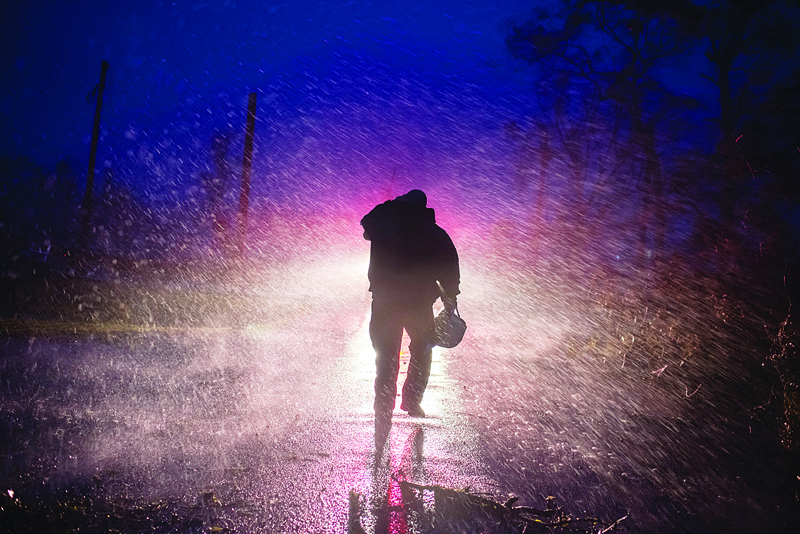 BOURG: Montegut fire chief Toby Henry walks back to his fire truck in the rain as firefighters cut through trees on the road in Bourg, Louisiana as Hurricane Ida passes Sunday.-AFP
BOURG: Montegut fire chief Toby Henry walks back to his fire truck in the rain as firefighters cut through trees on the road in Bourg, Louisiana as Hurricane Ida passes Sunday.-AFPNEW ORLEANS, US: Powerful Hurricane Ida battered the southern US state of Louisiana, leaving at least one dead and knocking out power for more than a million people, including the whole of New Orleans. Ida slammed into the Louisiana coast as a Category 4 storm on Sunday, 16 years to the day after Hurricane Katrina devastated New Orleans, but had weakened to a tropical storm early Monday.
The storm knocked out power for all of New Orleans, with more than a million customers across Louisiana without power, according to outage tracker PowerOutage.US. "We have now lost power, citywide! This is the time to continue to remain in your safe places. It isn't a time to venture out!!," New Orleans mayor LaToya Cantrell said on Twitter. Electricity provider Entergy said it was providing back-up power to New Orleans Sewerage and Water Board, which operates the pumping stations used to control flooding.
The National Weather Service issued warnings of storm surges and flash floods for several areas, including the town of Jean Lafitte, just south of New Orleans, where mayor Tim Kerner said the rapidly rising waters had overtopped the 7.5-foot-high (2.3-meter) levees. "Total devastation, catastrophic, our town levees have been overtopped," Kerner told ABC-affiliate WGNO.
"We have anywhere between 75 to 200 people stranded in Barataria," after a barge took out the swing bridge to the island. "The winds are still too strong, we can't put boats in the water to get to them," he told WGNO. "This is a very dangerous situation. I've never seen so much water in my life," he said. Cynthia Lee Sheng, president of Jefferson Parish covering part of the Greater New Orleans area, said people were sheltering in their attics. "We really believe the calls coming in here to our emergency operations center, is that people are in attics in Lower Lafitte," she told WGNO.
She said the power was out but rescue teams, including the Louisiana National Guard, were ready to help once they can safely get to the area. Several residents of LaPlace, just upstream from New Orleans, posted appeals for help on social media, saying they were trapped by rising flood waters. President Joe Biden, who described Ida as "a life-threatening storm," declared a major disaster for Louisiana, which gives it access to federal aid. One person was killed by a falling tree in Prairieville, 60 miles northwest of New Orleans, the Ascension Parish Sheriff's Office said.
Throughout Sunday showers and strong winds swept New Orleans' deserted streets, buffeting boarded-up windows at businesses and homes surrounded by sandbags. Louisiana Governor John Bel Edwards said Ida could be the most powerful storm to hit the state since 1850. "There is no doubt that the coming days and weeks are going to be extremely difficult," he said at a briefing Sunday.
Not sure if I'm prepared
Most residents had heeded warnings of catastrophic damage and authorities' instructions to flee. In one neighborhood in eastern New Orleans, a few residents were completing preparations just hours before landfall. "I'm not sure if I'm prepared," said Charles Fields, who was bringing his garden furniture indoors, "but we just have to ride it." "We'll see how it holds up," added the 60-year-old, who in 2005 saw Hurricane Katrina flood his house with 11 feet (3.3 meters) of water.
'Very serious test'
Governor Edwards warned on Sunday that Ida would be "a very serious test for our levee systems," an extensive network of pumps, gates and earthen and concrete berms that was expanded after Katrina. He told CNN that hundreds of thousands of residents were believed to have evacuated. The storm "presents some very challenging difficulties for us, with the hospitals being so full of COVID patients," he said. With a low rate of vaccination, Louisiana is among the states hit hardest by the pandemic, severely stressing hospitals.
Hospitalizations, at 2,700 on Saturday, are near their pandemic high. The memory of Katrina, which made landfall on August 29, 2005, is still fresh in Louisiana, where it caused some 1,800 deaths and billions of dollars in damage. Rainfall of 10 to 18 inches (25 to 46 centimeters) is expected in parts of southern Louisiana through Monday, with up to 24 inches in some areas.
As of 4 am Monday, the storm was packing maximum sustained winds of 60 miles per hour (97 kph) and was expected to continue weakening as it moves over land, with a predicted track taking it north over the central United States before veering eastward, reaching the mid-Atlantic region by Wednesday. The White House said Sunday that federal agencies had deployed more than 2,000 emergency workers to the region-including 13 urban search-and-rescue teams-along with food and water supplies and electric generators. Scientists have warned of a rise in cyclone activity as the ocean surface warms due to climate change, posing an increasing threat to the world's coastal communities. -AFP










